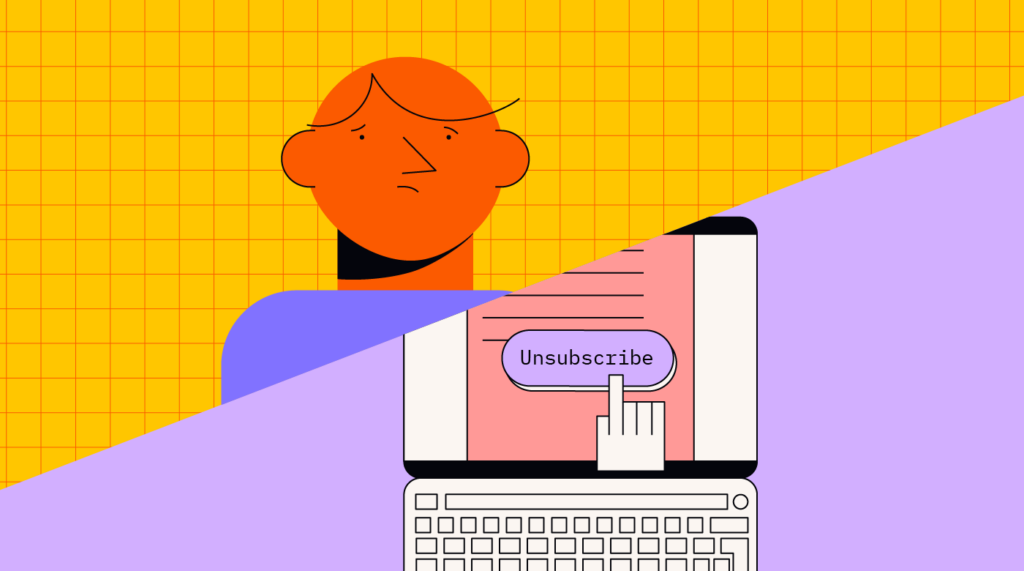Forbes tells us 85% of customer churn is preventable. The ball is in your court!
Customer retention should be a number-one priority for every company. Even though customer churn is a natural occurrence that cannot be eliminated altogether, it can be minimized with a proactive approach to customer service and by taking care of your existing customers.
Below we discuss customer churn—what it is, how to predict it, how to analyze it, and ultimately how to reduce it. But for now, let's put customer churn under a microscope, ask the question that's on everyone's mind ("What's a good churn rate?"), and figure out together what our next steps should be.
What is customer churn (AKA customer attrition)?
In a sentence: it’s a situation in which customers stop buying your products or ordering your services. In harsher words, they stop being your customers. Of course, your goal is to keep customer churn as low as possible, as it directly affects your revenue, business stability, and cash flow. Stable and profitable businesses usually have relatively low customer churn rates. (We'll get into that in a moment, but feel free to skip ahead.)
What causes customer churn?
The truth is there can be hundreds of reasons for customer churn. In his presentation from 2015, Esteban Kolsky even explains that for 50% of your customers, churn naturally happens over a five-year period. Some customers leave because they no longer need a given company’s services (think pest control services or baby stores). Others do so because they have found a better alternative to what you offer.
More often than not, though, customer churn is a direct result of bad customer experiences. According to Zendesk, just one poor customer experience is enough for the majority of your customers to switch to one of your competitors:
On the other hand, good customer experience is a valid reason for the vast majority of customers to stay with your company over a longer period of time and buy more products.
Now, let's have a look at how to calculate the customer churn rate in a snap.
What is Customer churn rate?
It’s a percentage value showing how many customers churn from your company. Typically, it’s calculated for a specific period of time, such as a month or a year. You can calculate this rate yourself using this simple formula:

So, for instance, if your company had 500 customers at the beginning of the month and you lost 50 customers, the churn rate is 10%. But what does it actually mean, and why should you care about your churn rate?
Why is the customer churn rate important?
Put shortly, the churn rate shows how stable your business is. It also provides some information on whether customers are satisfied with your company’s offer and customer service. Low customer satisfaction directly translates into high customer churn, but when you care about customer success and take care of their experiences, brand loyalty goes up, and you'll lose fewer customers.
It's also important to distinguish two types of customer churn:
- Voluntary churn: This occurs when a customer knowingly decides to stop using your service.
- Involuntary churn: This happens when a customer accidentally stops using your service, e.g., because they forgot to pay a bill or to schedule the next appointment.
All in all, your obvious goal is to keep customer churn as low as possible. Now, let’s have a look at different customer churn rates and figure out how your org stacks up.
What is a good churn rate?
While there are no universal thresholds for churn rates, and they differ between industries, we can generally say that:
- Every result below 5% is good (mind you, B2B churn is usually lower as the purchasing process in this sector is far more complex compared to B2C).
- The 5-7% result is average.
- Everything above 7% is a poor result and should trigger you to take a closer look at your company.
In 2022, Recurly.com published customer churn benchmarks. According to their findings, average churn rates are as follows:
- B2B: 4.91%
- B2C: 6.77%
- Voluntary churn: 3.95%
- Involuntary churn: 1.38%
But again, you need to keep in mind that these are general results. For example, the software sector will have a lower churn compared to consumer goods, because for these customers, switching to a different company is pretty complicated and time-consuming compared to purchase decisions for clothing or breakfast cereal.

Let’s have a look at the approximate churn rates for six major market sectors:
The ARPC (average revenue per customer) index also matters. The same source indicates that for 71% of respondents, the price increase is the number-one reason for subscription cancellation. The hard and fast rule is that the higher the ARPC, the higher the customer churn rate:
Customer churn analysis should always be done in the context of LTV (customer lifetime value). If your LTV is high, losing one customer can really hurt your revenue, as every customer brings a lot of money into your company. On the other hand, if you run a company with a low LTV (think streaming services), losing a customer is a slightly smaller problem, and if you have a large customer base, you probably won’t even notice it.
Whatever the case, you should strive to lower customer churn to protect your bottom line. Here are 10 practical tips to help you do just that.
10 tips for Protecting Your customer churn Rate
Never stop looking for new customers!
I know how this sounds, but the truth is the best way of dealing with customer churn once and for all is all about acquiring new customers - all the time. Never rest on your laurels, and implement performance marketing techniques that will help you reach new customer sectors and audiences. This way, even if some customers do leave your company, your overall balance of profits and losses is good.
1. Ensure you truly understand your customers
Customer acquisition, as well as retaining existing customers, is all about understanding their needs and reacting to them. There are many tools you can use to understand your customers better, from customer surveys through web analytics to studying market reports and white papers. You can use this knowledge to create realistic customer personas.
2. Map and analyze the customer journey
Walk in your customers' shoes by mapping the entire purchasing process in your company and create a customer journey map depicting what happens at each stage, from onboarding or the first contact to the advocacy/retention stage. Mapping the customer journey helps you understand how specific communication channels in your company work and what touchpoints have an influence on customer satisfaction.
3. See what your competitors do to keep their customers
Competitive analysis is always a good idea. Check your competitors’ offers. What do they do to encourage people to stay with them? Perhaps you will be able to implement some of these ideas in your business. Web analytics and social listening tools can help you gather the necessary knowledge. See what people value your competitors for and what elements of their offer make them stand out.
4. Train your team
Good customer service is something that can be trained. If your team struggles with satisfying your customers’ or subscribers’ needs, you probably need to put more effort into training your CS consultants and other front-line employees. A tailor-made training program can work miracles, provided it’s based on real customers’ needs and expectations.
5. Analyze your customer sentiment
Do you really know what customers are saying about your brand? Do you know what they like and dislike about your service? If you want to mitigate customer churn, this is absolutely fundamental knowledge! You can find this out by using one of the many awesome sentiment analysis tools on the market.
6. Use available metrics and KPIs to build a customer-centric culture
Creating a customer-centric company is not an overnight task. It takes some work and effort, as well as the in-depth measurement of your customers’ expectations and needs. There are many tools enabling you to measure customer satisfaction (e.g., NPS and CES)—use them, and you will quickly discover what's driving customers to leave your company.
7. Employ customer service software that your reps can use effectively
Keeping tabs on every customer and every ticket can be challenging, especially if the total number of customers in your company exceeds 500. In such a situation, you need user-friendly customer service software that will help you manage all customer relationships. Ideally, you need a tool that comes with both CRM and messaging functionalities so that you can quickly react to emerging problems.
8. Take care of your current customers
Getting and acting on customer feedback is important, but there’s more to it. You need to really take care of your current customers. What do you do to ensure they’re satisfied with the cooperation with your company? Do you use any incentives to encourage them to buy more products? Do you have a loyalty program or a VIP club they can join (with benefits that are actually beneficial)? Finally, do you ever simply ask them what they would like to see from your organization? These straightforward steps can make all the difference because everyone wants to feel noticed and valued—especially if they're paying you.
10. Tweak your onboarding process
Granted, the last tip is mostly for SaaS companies, but if you can make onboarding a part of building good relations with your customers, you definitely should! You can learn a lot of great intel on smart onboarding practices in our Customer Onboarding ebook.
Save the Churning for Butter & Ice Cream
Although you can’t cut customer churn out of the picture, you can make it a minor problem in your company. Check back often for more on customer churn, and sign up for our awesome newsletter so you don't miss any goodies. It’s full of practical knowledge that will help you take your CX game to a whole new level, get more satisfied customers, and sent churn to the curb!





